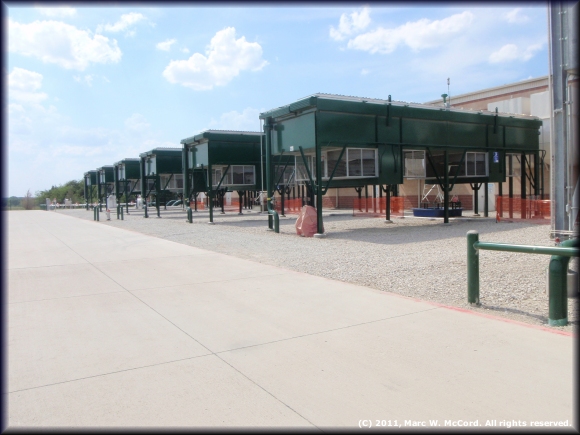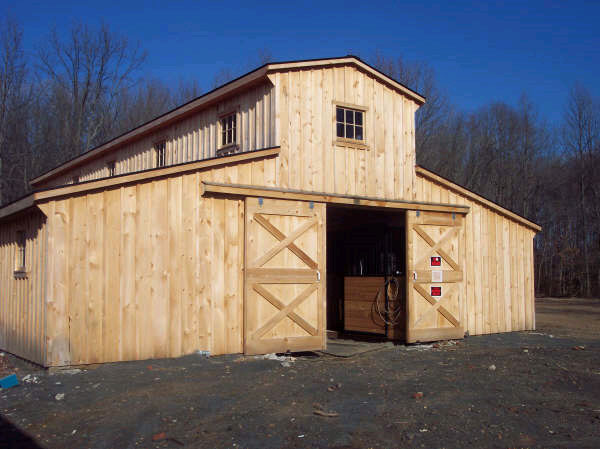Archive for July 2012
The Next Big Dallas Environmental Fight? Garbage Burning
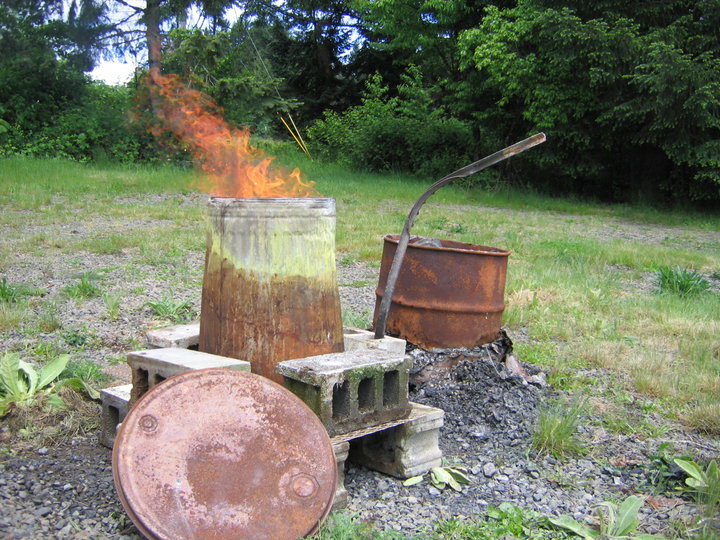 Many folks in the DFW environmental community think the battle over "flow control" at the McCommas Bluff landfill in Dallas is merely a prelude the the bigger goal of locating a large "materials recovery" operation there that will include a waste-to-energy power plant that can generate cash for City Hall as well as electricity. Once confined to the land-starved East Coast and Midwest, garbage burning is coming to Texas under the cover of recycling schemes that want to use it to make a buck instead of paying a landfill to take it.
Many folks in the DFW environmental community think the battle over "flow control" at the McCommas Bluff landfill in Dallas is merely a prelude the the bigger goal of locating a large "materials recovery" operation there that will include a waste-to-energy power plant that can generate cash for City Hall as well as electricity. Once confined to the land-starved East Coast and Midwest, garbage burning is coming to Texas under the cover of recycling schemes that want to use it to make a buck instead of paying a landfill to take it.
A wave of garbage-burning permits have been approved across the country over the last 2-3 years at various cement plants, including the TXI kiln in Midlothian, south of Dallas, which can now burn plastic wastes and the non-steel parts of cars, including brake linings, electronic switches, vinyl covers, mats, and dashboards. Now the groundwork is being put in place to extend that practice into municipal garbage burning using power plants.
The sale pitch sounds great. The waste companies and city will be "completely committed" to recycling and reusing as much waste as possible. They'll only burn a "small percentage of leftover waste" that would otherwise go to a landfill. It has "significant BTU value" and it "reduces pollution" when you burn it! Why bury it when you can use it to make power that people need. It's really just like recycling!
Except it isn't. It's garbage burning. It's burning plastics. It's burning "fibers." It's burning teated lumber. It's burning "a small list of alternative fuels" and when there's not a enough of that stuff to generate the required power, the list expands. And it produces more air pollution, and distributes that air pollution over a much larger area, affecting many more people, than the same amount of garbage continuing to go to a landfill.
The 20-year fight over burning hazardous wastes at TXI and the other Midlothian cement plants began with the companies telling residents that they were "recycling flammable liquids" in kilns that reached almost 2000 degrees, and burned up 99.99% of all the waste. Soon, the cement kilns were mixing in non-flammable solids like toxic metals, and wastes with chlorine, and contaminated water that had little or no BTU value at all. And far from removing 99.99% of the bad stuff, the kilns added a toxic soup of chemicals to their already voluminous amounts of air pollution.
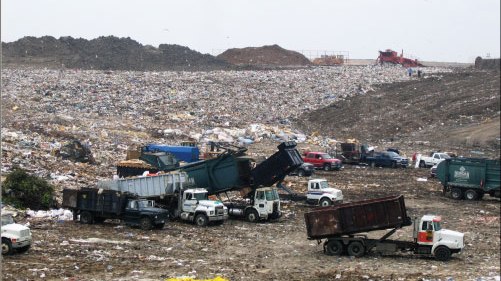 A landfill's toxic plume is usually slow-moving, flows only downhill, and can be tracked as it goes through soil. An incinerator's plume is blowing toxic air pollution wherever the wind is blowing, traveling as far the the wind will carry it, and changes from day to day, often eluding monitors if they're not in exactly the right place. Then, after all that, there's the problem of what to do with all the toxic ash. Send it to a landfill. Which practice puts more people in harm's way? Which one affects public health more? Which is the more sustainable alternative?
A landfill's toxic plume is usually slow-moving, flows only downhill, and can be tracked as it goes through soil. An incinerator's plume is blowing toxic air pollution wherever the wind is blowing, traveling as far the the wind will carry it, and changes from day to day, often eluding monitors if they're not in exactly the right place. Then, after all that, there's the problem of what to do with all the toxic ash. Send it to a landfill. Which practice puts more people in harm's way? Which one affects public health more? Which is the more sustainable alternative?
As a means of getting tuned up for the fight ahead, which some rumors put as near as this fall or winter, let's examine a little study partially sponsored by the American Chemical Council that was published the other day with the intent of setting the stage for widespread garbage, sorry, "refuse" burning.
It comes from UT – where another study on energy just got a lot of unfavorable publicity. This time It's Dr. Michael Webber who's Associate Director of the Center for International Energy and Environmental Policy in the Jackson School of Geosciences, Co-Director of the Clean Energy Incubator at the Austin Technology Incubator, Fellow of the Strauss Center for International Security and Law at the LBJ School of Public Affairs, and Assistant Professor of Mechanical Engineering at the University of Texas at Austin. Whew.
He's also a member of the "Pecan Street Project" in Austin, which is a "citywide, multi-institutional effort in Austin to create the electricity and water utilities of the future by the innovation and implementation of smart grids, smart meters, and smart appliances. The Pecan Street Project team includes UT, the City of Austin, Austin Energy, the Environmental Defense Fund, the Austin Technology Incubator, and eleven corporate partners."
See? Already the guy has impeccable credentials.
And what is Dr. Webber and the American Chemical council selling today?
"If 5% of residual waste from recycling facilities were diverted to energy recovery, it would generate enough power for around 700,000 American homes annually."
First, you understand that Dallas alone has more than 700,000 homes, and so we're talking about burning 5% of the entire nation's leftovers to get electrical energy for a city smaller than Dallas…for a year.
Second, does anyone know how many waste incinerators would have to be built and and what cost, or how they'd be financed? Nope. But we digress….
"The study found that while single-stream recycling has helped divert millions of tons of waste from landfills in the U.S. – where recycling rates for municipal solid waste are currently over 30% – Material Recycling Facilities (MRFs) currently landfill between 5% and 15% of total processed of the material treated as residue.
According to the researchers this residue is primarily composed of high energy content non-recycled plastics and fibre.
The report proposed that one possible end-of-life solution for these energy dense materials is to process the residue into Solid Recovered Fuel (SRF) that can be used as an alternative energy source capable of replacing or supplementing fuel sources such as coal, natural gas, petroleum coke, or biomass in many industrial and power production processes."
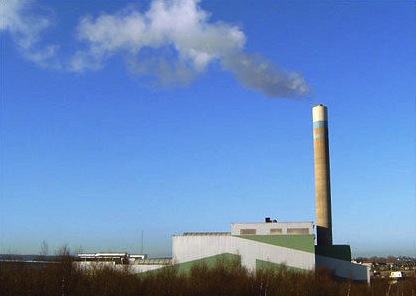 You will be unsurprised to learn that a cement kiln was involved in "testing" how well the
You will be unsurprised to learn that a cement kiln was involved in "testing" how well the garbage, sorry, SRF burned. Because it can reach temperatures of almost 2000 degrees!
But the results are not exactly spectacular in the way the Chemical Council probably anticipated.
Sulfur Dioxide (Sox) pollution was reportedly reduced over what coal alone would have emitted by some 20 to 44% (the study rounds this number up to "roughly 50%"). OK. but that's what SOx "scrubbers" are for. The study doesn't say whether the kiln used for the experiment had scrubbers on it. Not a lot of them do right now, but most power plants do and any new power plant or cement kiln would have to have them as well. Both the TXI and Holcim dry kilns have scrubbers already, and the new Ash Grove dry kiln will as well. These scrubbers can reduce SOx pollution by over 80%. So can we agree that we're better off just adding scrubbers to facilities instead of setting fire to plastic garbage to reduce this kind of air pollution?
On the other hand Nitrogen Oxide (NOx) pollution reportedly went up 25% to as much as 93%, when garbage was burned compared to coal. This spike was explained away by saying the kiln didn't have a proper delivery system for the garbage to reach the kiln. That's untested speculation by the authors that may or may not be true. Any increase in smog-forming NOx pollution would be hard to sell in an area like DFW that's been in violation of federal smog standards for over 20 years.
CO2 emissions were reportedly reduced by a paltry 1.5% – the equivalent to getting a million cars off the road! But that's another small number when you realize that just treating the CO2 from the three Midlothian cement plants here in North Texas would get you that number or something even bigger.
When you burn plastic you get dioxins – one of the most toxic substances in the world. The Chemical Council knows this. But there was no testing for dioxins, or phthalates, or any of the more exotic kinds of air pollution one would expect to see when you burn plastics and other kinds of garbage. This is one of the primary objections citizens would have about this practice, and yet there was no testing for it.
These results may not seem that great to you, but they impressed both the Chemical Council and Dr. Webber.
"In this case, one person's trash truly is another person's treasure. Americans send tons of waste to landfills each and every day, meaning that one of America's most abundant and affordable sources of energy ends up buried in landfills," commented Cal Dooley, president and CEO of ACC.
"It's time we got smart and made energy recovery a central part of America's energy strategy," he added.
Meanwhile Dr. Webber added: "The findings from our study demonstrate how engineered fuels can make a meaningful contribution to our nation's strategy while reducing carbon and sulfur emissions compared to some forms of energy,"
Let's translate: "Your trash is our potential treasure. We can't portray ourselves as "Green" if we don't find some way to make plastics more eco-friendly. Plus, we can make a buck packaging our garbage for you to burn it. Our findings show that under these very controlled circumstances, and with not too many questions asked, burning garbage can make some minimal pollution reductions that other readily available alternatives could make better, while also increasing the kind of pollution that most people don't want."
This fight over garbage burning will be as big, if not bigger than the fight over gas drilling. It will involve environmental justice issues, toxic pollution, private-public contracts, sustainability, and real recycling vs the fake kind. And lots and lots of doublespeak. Get your waders on.
What To Expect When You’re Expecting Gas Drilling
If you're a Dallas resident and you want to find out more about the kinds of new facilities that might be located near you if gas drilling is allowed in your city per the new ordinance the Council is debating on August 1st, here's a item of interest from West Virginia, where operators are already fracking.
"Sulfur dioxide, carbon monoxide and formaldehyde are some of the chemicals Chesapeake Energy is likely to pump into the air in Ohio County from its numerous drilling sites, company information states.
Earlier this year, Chesapeake officials confirmed plans to build local compressor stations that may release these and other chemicals into the atmosphere. Now, the company is identifying "potential to emit" levels for several potentially hazardous materials from its well drilling sites.
The amounts of the particulates that may be released at the four sites slightly vary. The carbon monoxide projections, for example, range from 40 tons per year to 61.5 tons per year to be released from a single site.
In addition to the pollution from the well sites, Chesapeake also will release emissions from its local compressor stations. Chesapeake, in a legal advertisement earlier this year, confirmed the "potential to discharge" the following amounts of these materials on an annual basis from the operations at the compressor stations: carbon dioxide – 93,800 tons; nitrogen oxides – 82.96 tons; carbon monoxide – 16.87 tons; methane – 86.64; carbon dioxide equivalent – 95,667 tons; benzene – 0.33 tons; and formaldehyde – 3.22 tons."
Formaldehyde and Benzene are both carcinogens. Carbon Dioxide is the primary greenhouse gas pollutant, and methane is right behind. Nitrogen Oxide is the primary component of smog in DFW. All this – 93,000 tons a year of air pollution – from just one gas compressor. Where in Dallas would you propose to put a facility that spews that much air pollution? And how would you keep it from adding to the chronic air quality problem the City already has? And then what about the fact that the operators might not need just one, but three, or five, or ten of these compressors in Dallas? It's not uncommon to build complexes that house as many as a dozen or more locomotive-size compressors in the Barnett Shale, which includes at least the western half of Dallas.
When you allow drilling, you're allowing everything else that follows drilling, including compressors and their pollution, storage tanks that leak copious amounts of the same kind of pollution, pipelines that can use eminent domain to run through your front yard, and a host of other hazards, some of which we know about, some of which we no doubt have not yet discovered. Gas mining is not conducive to neighborhoods or attracting new, non-polluting development. If Dallas City Hall doesn't know this now, it most certainly will learn it later.
Groups Demand DFW Hearing on EPA’s Rollback of Cement Plant Rules
 In a letter sent Tuesday, ten grassroots and national groups from across the country, including Downwinders at Risk, joined together to call on EPA to schedule a public hearing in Dallas-Ft. Worth on its proposed rollback of cement plant emission rules.
In a letter sent Tuesday, ten grassroots and national groups from across the country, including Downwinders at Risk, joined together to call on EPA to schedule a public hearing in Dallas-Ft. Worth on its proposed rollback of cement plant emission rules.
In publishing the revised rules in the Federal Register last week, EPA proposed only one public hearing be held on August 2nd in North Carolina, where there is not a single operating cement plant, although the proposed new giant Titan cement plant is trying to win permit approval to operate near Cape Fear.
Downwinders was joined by Montanans Against Toxic Burning out of Bozeman; Montana Environmental Information Center in Helena; Selkirk, Coeymans, Ravena Against Pollution (SCRAP) in upstate New York; California Communities Against Toxics, based in Rosamond, the Stop Titan Action Network, Penderwatch and Conservancy, Cafe Fear River Watch, and North Carolina Coastal Federation, all from the Tarheel state, as well as Earthjustice, the DC-based legal defense team that has partnered with Downwinders and many of the other groups for 20 years in trying to get these new rules implemented.
In 2009, DFW was one of three metropolitan areas that hosted public hearings on the then-proposed rules, referred to as National Emission Standards for Hazardous Air Pollutants, or NESHAP. Over 200 people attended at the impossible-to-get-to DFW Airport Hotel and almost 100 testified – more than participated in the DC and LA hearings combined. All but five testified in favor of strong EPA regulation of cement plant emissions.
DFW is also downwind of the nation's largest concentration of cement plant manufacturing capacity, with three large plants and a total of six kilns operating today in Midlothian, in Ellis County.
EPA's changes to the rules, which include moving the compliance deadline from 2013 to 2015, as well as loosening the Particulate Matter standards and eliminating real time monitoring of PM pollution, were proposed just as the rules were about to be finalized and signed into law. No one at EPA can explain exactly why. No judge asked them to. The public didn't demand it. The Administration seems to be going out of its way to find favor with the cement industry even as the EPA is still carrying on a massive national enforcement initiative against it.
If you haven't done so already, please click here and send your comments opposing the changes in the cement plant emission rules. You only have until August 17th.
The full text of the groups' letter:
We, the undersigned groups, respectfully request that the Environmental Protection Agency hold a public hearing in Dallas, TX on its recently re-proposed NESHAP rule for Portland cement kilns. We request that this hearing be held in addition to the hearing scheduled at the Research Triangle Park facility in North Carolina.
There are no cement plants operating in North Carolina. It is incredibly important for the EPA to hold at least one public hearing in a location that is directly impacted by the toxic air pollution that this NESHAP rule addresses. Dallas is an appropriate additional hearing location for numerous reasons. First, there are multiple cement plants in the vicinity. Second, there is a precedent for public hearings on this rule in the region— on June 17, 2009, the EPA held a productive public hearing in Dallas on the Portland cement NESHAP. Third, Dallas's central location is more convenient for other impacted citizens from across the country who wish to travel to provide testimony.
We have worked for more than a decade to secure strong protections against the emissions of mercury, arsenic and other toxic air pollutants that cement plants emit. We would appreciate the opportunity to continue our involvement on this important issue at an additional public hearing in Dallas.
Smog Update: On the Brink
 Strong winds are usually among the most efficient smog-stoppers DFW has. Despite this last week's record-setting heat wave, ozone levels didn't go crazy like they did in June because the winds kept blowing. Only the Rockwall monitor recorded an "exceedance" of the 1997 85 parts per billion ozone standard on Saturday, it's first of the season.
Strong winds are usually among the most efficient smog-stoppers DFW has. Despite this last week's record-setting heat wave, ozone levels didn't go crazy like they did in June because the winds kept blowing. Only the Rockwall monitor recorded an "exceedance" of the 1997 85 parts per billion ozone standard on Saturday, it's first of the season.
That makes 17 out of 20 DFW monitors that have at least one such exceedance of the 85 ppb standard. 11 of 20 have at least two. 7 out of 20 have at least three. And 2 out of 20 already have the four exceedances they need to be registered as a violation of the standard (a "non-attainment area" ozone monitor gets three strikes before the fourth-highest reading gets counted against it).
That means we're just one bad air day away from seeing five more monitors record their fourth exceedance and become violators. Two bad days away from having nine – and August is traditionally much worse for ozone than July.
In 2010, there were two monitors in violation of the 85 ppb standard. Last year there were seven. Industry and state government have been trying to tell the public DFW is still making air quality progress despite these numbers – that last year was just an anomaly because of the drought. Not sure how they'll spin another year of seven or more monitors out of whack with a 15-year old smog standard
Let's remind everyone again that according to Governor Perry's three TCEQ Commissioners, there were going to be no violations of the 85 ppb standard this year, that this is the second state plan in a row to fail to meet the 85 ppb standard, and that the new EPA smog standard is 75 ppb. Heck of a job TCEQ.
Four Years Later, State Gets Around to Issuing Clean Air Plan for Exide That Won’t Apply
In 2008, the EPA issued a new lead-in-air standard for all U.S. lead smelters.
In 2011, the Texas Commission on Environmental Quality finaly submitted its first proposed plan to meet that new standard in Frisco, Texas, host of the Exide lead smelter. It was rejected as inadequate by EPA on the same day it was submitted.
In May of 2012, the City of Frisco and Exide reached a settlement that commits the company to ceasing the operation of its Frisco smelter on December 31st, 2012.
Last week, the Texas Commission On Environmental Quality released its second plan to meet the 2008 EPA lead-in-air standard at the Exide smelter in Frisco. Its effective date is December 31st, 2014, or two years after Exide will have closed per its agreement with the City of Frisco.
The plan and the accompanying Agreed Order doesn't incude any fines or enforcement measures that address the dozens of violations detailed by TCEQ inspectors at the Exide smelter just last year. Nor does it address the closure and adequate clean-up of the smelter once operations cease.
Between 2008 and the end of this year, Exide will have released an estimated 14,000-16,000 pounds of lead into the air in Frisco.
If you're thinking that this TCEQ planning document is irrelevant, you'd be pretty close to summarizing not only this episode, but decades of state oversight. And yes, this is why it's important to have citizens suing Exide themselves to enforce the law rather than Waiting for Godot TCEQ.
Another Day, Another White House Retreat on Clean Air
 In an election year, apparently no environmental initiative is safe from the Obama White House.
In an election year, apparently no environmental initiative is safe from the Obama White House.
You may have missed this because it was one of those late Friday government announcments that officials like to use to bury bad news, but the EPA is going to consider softening those much-ballyhooed coal plant Mercury emissions rules that it fought so hard to get only last year. And because "consider" in this case means "we're going to do it," you can add these rules to the growing list of those clean air efforts in this supposedly environmentally-friendly administration that have bitten the dust because of political interfernce.
One of the reasons this rule is being rewritten is to satisfy the less-than-state-of-the-art White Stallion coal and pet coke-fired power plant being proposed for Matgorda Bay, whose owners have campaigned against the new rules since Day One. They say the rules are too strict and can't be met, despite being based on the track record of top performers in the utility industry. You will be unsurprised to learn that the Texas Commission on Environmental Quality is a co-facilitator in that campaign, up to the point of being so enthusiastic in its unquestioned support that it had to be ordered by a state judge to reconsider the first air permit it gave the plant because of the lack of any public participation.
White Stallion is going to be built less than 20 miles from the boundary of the eight-county Houston "non-attainment area" for ozone, or smog. Regulations on new sources of industrail pollution are tighter inside such areas than outside. That's pretty much all you need to know about the owner's commitment to using best technology. It's the same problem DFW used to face with the Midlothian cement plants and Ellis County until Donwiwnders petitioned, and EPA agreed, to include them in the North Texas non-attainment area.
Anything that makes it harder for Houston to meet clean air standards, also makes it harder for DFW to do the same. But this rollback is also a shame because of this administration's gap between promise and performance when it comes to critical upgrades in national polluiton standards – ozone, particulate matter, cement kilns and now coal plants. When push comes to shove, there seemingly isn't any polluter this White House won't do a favor for between now and November.
Low Birth Weight Pregnancies 25% More Likely Within 1.5 miles of Fracking
 A mother's exposure to fracking increases the chance a a low weight birth by 25%, according to a new study by Elaine Hill, a doctoral candidate at Cornell University. Hill's research also found a 17% increase in "small for gestational age" births and reduced health scores among newborns whose moms lived close to fracking sites.
A mother's exposure to fracking increases the chance a a low weight birth by 25%, according to a new study by Elaine Hill, a doctoral candidate at Cornell University. Hill's research also found a 17% increase in "small for gestational age" births and reduced health scores among newborns whose moms lived close to fracking sites.
“Unconventional Natural Gas Development and Infant Health: Evidence from Pennsylvania” is the working title of the study, which has not yet been peer-reviewed or journal-published. Hill used data from 2010 and focused on those living up to 1.5 miles from gas development sites. Pennsylvania increased its unconventional natural gas wells from 20 in 2007 to 4,272 by the end of 2010.
Hill publicized her findings at a public hearing in New York state, which is considering new regulations for fracking. She decided to come forward now, rather than wait for up to two years for the review process to accredit her research because she believes her study has implications policy makers need to incorporate into those regulations.
“My study is robust across multiple specifications and it indicates that our future generation may be seriously harmed. I couldn’t possibly value my career over their well-being,” Hill said by email last Thursday.
We already have a Colorado School of Public health study released in March that shows a 66% higher chance of getting cancer if you live within a half mile of a fracking site. Hill's study is the first to track health effects up to a mile and a half away.
These reports are in addition to the hazard of earthquakes now officially linked to fracking waste injection wells by the US Geological Society, and the risk of getting silicosis from breathing in illegal levels of sand particles noted by industrial hygienists – both from earlier this year. All of this is new research that didn't exist before 2012. What other hazards are we ignorant of this year?
Just another reason why you should be at Dallas City Hall at 9 am on Wednesday, August 1st for the Thrilla on Marilla.
Rejected Smog Standard Would Have Saved 4100 Lives Annually – including DFW Residents
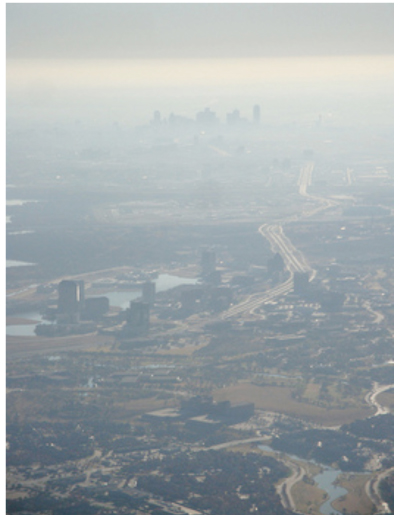 The EPA-proposed ozone/smog standard of 70 parts per billion the White House rejected at the last minute in 2011 would have saved almost twice as many lives per year over and above the Bush-era standard of 75 ppb that was eventually adopted, according to a new study by John Hopkins University scientists.
The EPA-proposed ozone/smog standard of 70 parts per billion the White House rejected at the last minute in 2011 would have saved almost twice as many lives per year over and above the Bush-era standard of 75 ppb that was eventually adopted, according to a new study by John Hopkins University scientists.
Most of those new leases on life would have come in large cities like New York, Chicago, and Los Angeles, where smog levels are historically high. But researcher say the standard would also have saved a significant number of DFW lives as well.
The lower standard was rejected by the Office of Management and Budget, and Executive Branch agency that has grown to have veto power over almost all EPA regulatory decisions based on their economic impact – a variable specifically excluded from consideration in the Clean Air Act.
The John Hopkins team also concluded that the lower 60 ppb standard that was in the lower range of what was recommended by EPA's own science advisory would have saved up to 8000 lives per year, compared with the 2500 annual lives estimated to be saved under the more lenient 75 ppb standard.
In addition to more lives saved, the study concluded that millions of asthma attacks and acute respiratory problems would be prevented with a lower ozone standard.
“We contend that a more stringent standard would prevent a substantial number of adverse health outcomes,” wrote the researchers, led by senior scientist Frank Curriero of the Johns Hopkins Bloomberg School of Public Health.
They calculated the reduced deaths by incorporating data from a variety of health studies around the country that have found that whenever ozone levels rise, deaths and hospitalizations from cardiovascular and respiratory problems rise, too.
There was also a warning that climate change would make higher ozone levels more likely, as seems to be in play this year with much of the country experiencing the kind of drought and heat Texas had last summer, and with national ozone level spiking.
EPA officials estimated that achieving the rejected 70 ppb standard would cost between $19 billion and $25 billion per year, including the estimated $8 billion for meeting the current standard set by the Bush administration in 2008. However, the agency estimated the health benefits would be worth $11 billion to $37 billion per year. Based on new evidence of medical costs associated with ozone pollution, that figure may have been very conservative.
The EPA's next review of the standard is supposed to begin in 2013. The Clean Air Act requires an evaluation every five years; Jackson, however, had planned to act early until Obama asked her to stop.
Meanwhile, DFW still can't meet the old 1997 85 ppb standard after three clean air plans in the last seven years. This year's fate is already sealed thanks to the June smog attack we had early on. Our worst monitors are averaging above 85 ppb and we haven't gotten to August – traditionally our worst month. Smog is taking its toll on our health in DFW, even if it doesn't make the nightly news.
State Farm Sending Letters To Johnson County Residents Offering Earthquake Insurance
 Following up on our follow-up….while no insurance companies offer homeowners protection against the hazards of fracking out right, State Farm seems to have figured out how to make money selling insurance for the symptoms of disposing of fracking waste. Buried deep inside this story on the recent wave of Johnson County earthquakes and their possible link to the County's numerous high-pressure injection wells for "fracking fluid" is the news that the Insurance giant sent out letters to Johnson County residents urging them to buy earthquake coverage.
Following up on our follow-up….while no insurance companies offer homeowners protection against the hazards of fracking out right, State Farm seems to have figured out how to make money selling insurance for the symptoms of disposing of fracking waste. Buried deep inside this story on the recent wave of Johnson County earthquakes and their possible link to the County's numerous high-pressure injection wells for "fracking fluid" is the news that the Insurance giant sent out letters to Johnson County residents urging them to buy earthquake coverage.
If, as recently as five or six years ago, an enterprising insurance agent had tried to sell a Cleburne resident earthquake insurance, he would have been investigated for fraud. This is how fracking has changed North Texas.
New Study: Reducing Smog Brings More Health Benefits
 In the same Washington Post article on the monkey business surrounding the new PM pollution standard comes news of a new study that concludes cutting smog pollution could bring added health care benefits that haven't been accurately estimated in the past.
In the same Washington Post article on the monkey business surrounding the new PM pollution standard comes news of a new study that concludes cutting smog pollution could bring added health care benefits that haven't been accurately estimated in the past.
Researchers at the University of California at Santa Barbara and MIT examined data for five years between 2003 and 2008 from the 20 Eastern states and the District of Columbia where power plants and boilers are required to limit nitrogen oxide pollution between May 1 and Sept. 30 each year – in other words, "oozne season."
During this time, they found prescription drug expenditures dropped by 1.9 percent, or $900 million a year, and the states and DC had 2,200 fewer annual premature deaths among individuals aged 75 or older.
“This is now new evidence of the evidence of the health benefits of ozone reductions, which was not available when the president overturned the previous effort to revise the ozone standard,” said MIT economist Michael Greenstone, who has informed White House officials of his findings.

